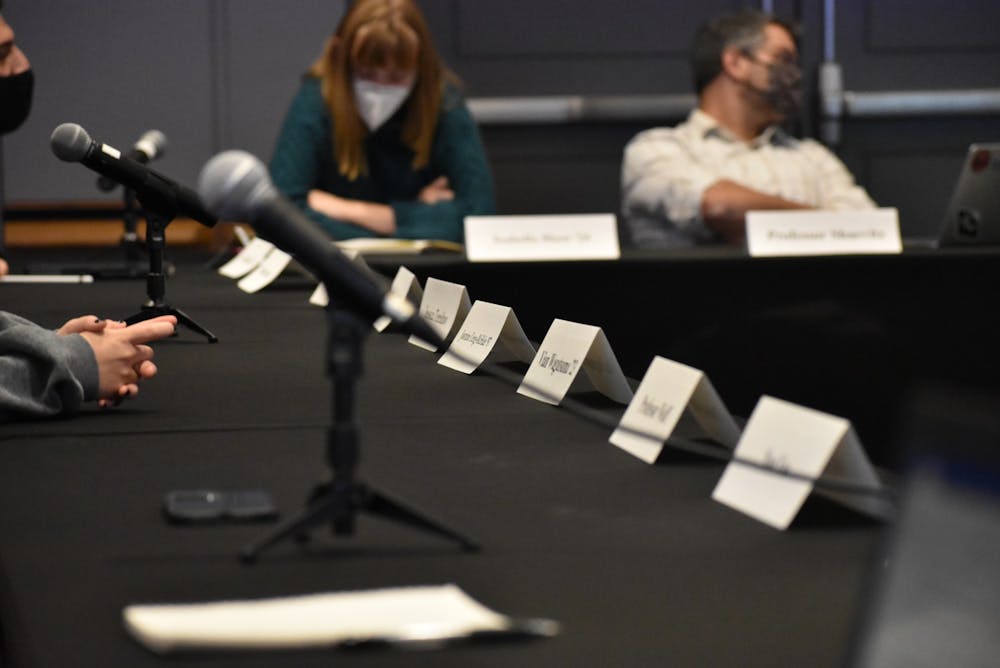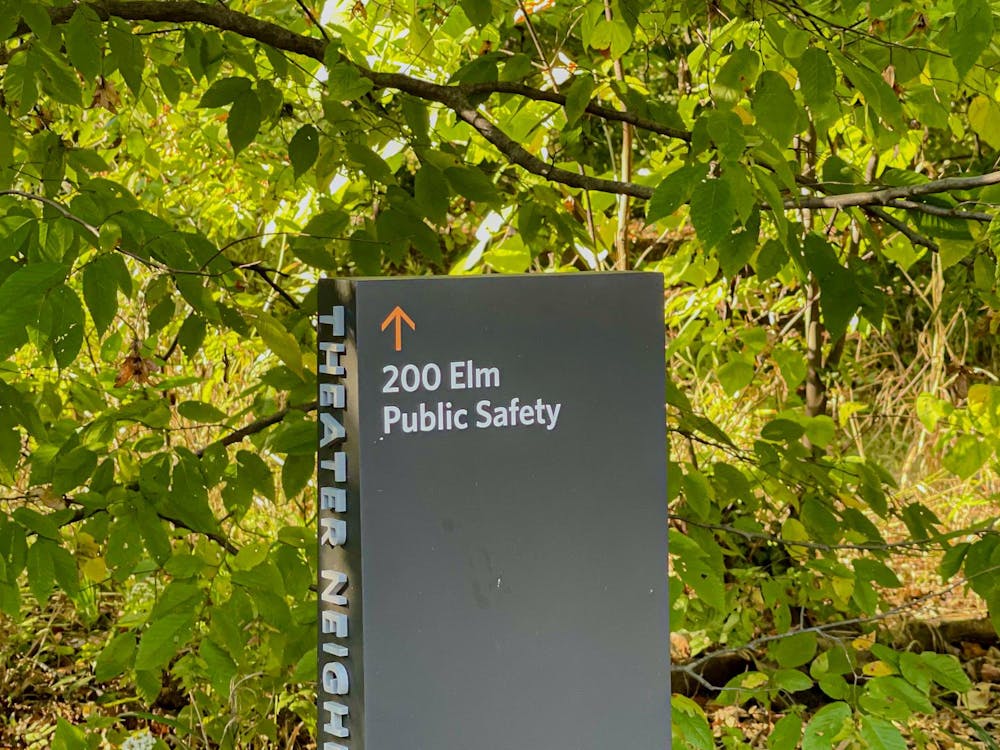The second Council of the Princeton University Community (CPUC) of 2023 took place on Monday, March 27, 2023. Administrators discussed security cameras outside residential colleges, student body expansion, programs to increase campus diversity through the Emma Bloomberg Center for Access and Opportunity, and policy that outlines recommendations regarding official statements. They answered questions from students and faculty related to each topic.
Here are five takeaways from the afternoon.
Committee forms to assess institutional neutrality for Princeton departments
Professor of Sociology and American Studies Shamus Khan chaired a sub-committee of the CPUC charged with writing a policy on institutional neutrality and opened his presentation by explaining the purpose of this effort.
Institutional neutrality, or compliance with the Kalven Report, has been a key topic of debate on campus, especially since controversial Palestinian writer Mohammed El-Kurd gave a talk on campus earlier this year. Some called on the department to condemn El-Kurd or to withdraw its statement on anti-racism. In a letter to Princeton Alumni Weekly, University President Christopher L. Eisgruber ’83 revealed the new committee on departmental statements, while defending the University not having a blanket principle of institutional neutrality.
“The aim of the committee was to develop a policy that would impact how different units of the University could issue statements in the voice of a collective,” Khan said. “This would be what you might think of as a ‘we believe statement.’”
The policy suggests three conditions for units to abide by in order to issue a statement of political concern. Khan explained, “Is silence untenable?” “Is speaking on the issue central to the functioning of the unit?” and “All units have to decide upon a process, a set of procedures they will decide upon if they wish to issue a statement.”

While the policy needs revision, Khan announced Monday an open feedback session for the next two weeks.
The policy does not apply to student groups, individuals, nor ad hoc members of the university.
The meeting was held on Monday, March 27 at 4:30 p.m. in the Frist Campus Center’s Multipurpose Room. CPUC’s next meeting will occur on Monday, May 1 from 4:30 p.m. to 6:00 p.m. in the same location and is open to all University community members.

Despite more student questions and concerns, University continues with security camera plans
The Princeton Department of Public Safety’s director of operations, Kinamo Lomon, and Vice President for Campus Life, W. Rochelle Calhoun, followed up on the University’s announcement that security cameras would be installed on campus. These cameras will be placed at residential college entrances to increase security on campus.
“We have obligations in this area to follow best practices in supporting and protecting the safety of our students,” President Eisgruber said.
Calhoun claimed student support for the program by citing a survey of 228 students conducted by the Undergraduate Student Government (USG) in November. The results showed about 50 percent of respondents favored security cameras while 35 percent opposed them. This was in the immediate aftermath of the death of Misrach Ewunetie ’24, whose death was later ruled a suicide.
During the meeting Monday, students raised concerns about privacy. They also questioned the extent to which administrators will watch these cameras and use footage as a tool to “prosecute” individuals for violations of University policy.
Calhoun explained that only approved University administrators will have access to recordings. She said the cameras will not record audio or use facial recognition.
“The primary use for this program is really to help in emergency situations and post-incident,” Calhoun stressed multiple times. “The use of this information will really be initiated if there is a concern or complaint about something that’s happened.”
The information presented remained consistent with a memo released to students, staff, and faculty on March 8.
Dolan cites more preceptors to address campus expansion, hints at student worker shortage
When admitting the class of 2026, the University intended to enroll an additional 125 students, but they ended up with an additional 200 due to a higher yield rate than expected.
Dean of the College Jill Dolan referred to the construction of two new colleges, Yeh and New College West, as one measure to address the expansion.
Dolan also reassured attendees that administrators continue to monitor admissions statistics and course selection as the campus expands so that they can offer more openings for classes in high demand.
After noticing shortages of teachers and growth in precept sizes, the academic policy group has decided, “departments with the most persistent and urgent need will be able to hire more preceptors so that department teaching requirements are met.”
Administrators also noted that with increasing financial aid, student employment may be affected. In the coming year, Princeton has pledged to award students whose families earn less than $100,000 a full scholarship without a student contribution requirement. For this reason, administrators will need to assess how many students will remain willing to work as class TAs and mentors during office hours.
Transfer Program hopes to expand from 60 to 100 students over the next few years
The Transfer Program at Princeton was restarted in 2018 with just nine students and seems to be following a trend of campus expansion.
Transfer students differ from Princeton students in key ways stemming from the fact that more than half of admitted individuals are military veterans. As a result the average age of transfer students is 26–27, significantly older than that of undergraduates on campus. These students often come with unique life experiences and families.
Dr. Keith Shaw, the Director of Transfer, Veteran and Non-Traditional Student Programs, articulated the challenges transfer students face.
“Many of our students report that they are trying to be double full-time: a full-time member of their family and full-time student and those aspects often work at cross-purposes,” he said. “We are trying to figure out how students and their families can do well while students feel they are part of the campus culture.”
The Emma Bloomberg Center for Access and Opportunity runs programs to support transfer students with an emphasis on strong advising during the first year. This includes work over the summer, an extensive pre-orientation program, and a revised writing seminar program.
On campus, students themselves have shown engagement in the Princeton community by creating two active student groups, Princeton Transfer Association and Princeton Student Veterans.
Princeton celebrates increase in Pell Grant-eligible students
The U.S. government awards Pell Grants to individuals who seek to pursue a college degree and have severe financial need. Today, about 21 percent of Princeton students are Pell Grant eligible, an increase from 7 percent in 2008. The Pell Grant is not available to international students so the total number of students enrolled at Princeton who are Pell Grant eligible ranges between 25 percent and 30 percent according to Khristina Gonzalez, Director of the Bloomberg Center.
After receiving funding in 2021, the Bloomberg Center began with a mission, “to provide all students, including those from first-generation, low-income, and underrepresented backgrounds, with the mentorship, academic enrichment, and community that they need to thrive.”
Gonzalez listed a variety of programs aimed at meeting this goal. Specifically, the Bloomberg Center monitors the Freshman Scholars Institute (FSI), a seven-week credit-bearing course that eases the transition between high school and academics at Princeton. When faculty saw a demand for a remote version, the University created the FSI online course to accommodate students with busy summer schedules.
“We are really thinking about this toggle between access and success,” Gonzalez said. “How do we ensure that all students have the opportunity to thrive at our institution and beyond?”
Rebecca Cunningham is an assistant News editor for the ‘Prince.’
Please send corrections to corrections[at]dailyprincetonian.com.








